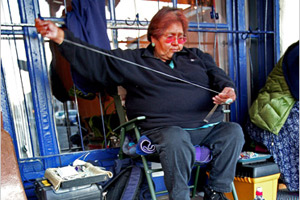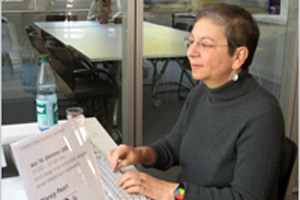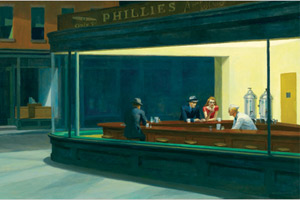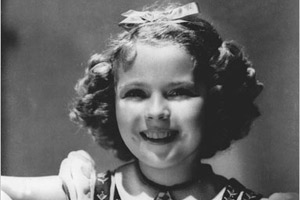Focus on America
History, Culture and Science Shape Central New Mexico

New Mexico’s 1st Congressional District is a swing district in a swing state. Situated in the geographic center of this southwest border state, the district climbs from desserts to mountains.
Most of the districts residents live in Albuquerque, the state capital. Since its founding in 1706, Albuquerque has grown from 18 families to more than 450,000 people.
Forty-two percent of the districts residents are of Hispanic origin, and American Indians represent a sizable part of the population. But many other ethnic groups call the New Mexico 1st home as well.
Ranches sprawling through the hills outside Albuquerque recall the Wild West, while scientists at the district’s national laboratories conduct cutting-edge research.
With such diverse geography, culture and economic activity within its boundaries, it is not surprising to find divergent political viewpoints in the New Mexico 1st.
Although registered Democrats outnumber Republicans in the district, Republicans have held the New Mexico 1st congressional seat for nearly 40 years. It has not been easy -- Heather Wilson, the current representative, won her last election by only 800 votes.
In 2004, the district barely favored Democratic presidential candidate John Kerry, while the state selected President Bush by less than 6,000 votes in one of the closest races in the country. But 6,000 votes seems a wide margin compared to the 2000 election when the state voted for Democrat Al Gore by only 300 votes. New Mexico is one of only three states that switched its support between parties in those two elections.
HISTORICAL ROOTS TRACED TO AMERICAN INDIANS, SPANISH
American Indians trace their history in the New Mexico 1st back thousands of years. Some of the houses they built in the past and rock carvings they made still are standing.
Spanish settlers arrived in the 1500s. The Villa de Alburquerque was founded by the Spanish in 1706. Eventually the first "r" in the citys name was dropped. The area became part of Mexico in 1821 and then part of the United States in 1846.
The arrival of the railroad in 1880 changed Albuquerques demographics, as immigrants from Europe and Asia mixed with American Indians, Hispanics and African Americans. The railroad also brought outlaws, who thrived in new Western towns without organized law enforcement. Many of legends of the Wild West originated in the region.
An American Indian artist makes and sells crafts in Albuquerque, New Mexico. (© AP Images)At the beginning of the 20th century, about a third of Albuquerques population was suffering from or assisting people with tuberculosis or other respiratory diseases. They came seeking the regions warm, dry climate, to which many attributed special healing powers.
As automobiles became more popular in the 1920s, more roads were built. Route 66, one of the original federal highways, went through Albuquerque, making it easier for more people to visit and settle in the area.
SCIENCE TRANSFORMS THE REGIONS ECONOMY
Central New Mexico has developed a variety of industries through its history. From sheep herding to railroad repair facilities, the main industries changed with the needs of the community.
The most drastic change to the economy began in the 1940s with the arrival of Kirtland Air Force Base. Sandia National Laboratories opened on the base in 1949 to research, develop and test nuclear weapons.
Today, Sandia researches the reliability and security of nuclear energy. Kirtland and Sandia are New Mexicos largest employers. Other major research companies are in the area as well. The world-renowned microprocessor company, Intel, is located in Rio Rancho. New Mexico claims to have the highest number of doctorate degree holders per capita of any U.S. state.
HISTORIC CULTURES CELEBRATED TODAY
With 22 American Indian tribes living in New Mexico today, American Indians in Albuquerque regularly host celebrations where they dress in traditional attire and perform dances and other rituals. Their arts, crafts and food are popular among tourists and locals.
In Old Town Albuquerque, one of the citys top tourist attractions, traditional adobe buildings have remained intact from early Spanish colonial days. A popular Christmas-time Hispanic tradition of setting up luminaries, paper bags weighted by sand with candles lit inside, continues annually.
But American Indians and the Spanish are not the only ones to influence the areas culture. The first African known to come to the United States arrived with the first Spanish settlers to New Mexico. Today, about 3 percent of Albuquerques population is African American. Chinese, Vietnamese, Japanese, Koreans and Filipinos have immigrated to the area in recent decades. Those looking for Asian restaurants and shops will find them in a part of the city nicknamed "Little Saigon."
The districts congressional seat is open in 2008 because Wilson, the incumbent, will be competing with many of New Mexicos biggest political names for an open Senate seat.
With an open House and Senate seats and a presidential election that potentially could be decided by the people of a small state such as New Mexico, the New Mexico 1st has the makings of a swing district the country will be watching closely in 2008.
Recently on Focus on America
Love of Books Survives in an Electronic Age
 It probably never was the dream of Nancy Pearl, author of Book Lust, to be the model for a “shushing” librarian action figure. Yet the bespectacled Pearl is not unpleased.
It probably never was the dream of Nancy Pearl, author of Book Lust, to be the model for a “shushing” librarian action figure. Yet the bespectacled Pearl is not unpleased.
Enigmatic Images from Edward Hopper Seen in New Exhibition
 Nighthawks, the mysterious 1942 painting of four people in a diner that has become one of the best-known images of 20th-century America, is among the many striking works in a retrospective of artist Edward Hopper's work at Washington’s National Gallery of Art.
Nighthawks, the mysterious 1942 painting of four people in a diner that has become one of the best-known images of 20th-century America, is among the many striking works in a retrospective of artist Edward Hopper's work at Washington’s National Gallery of Art.
History of Actors in U.S. Politics Goes Back Decades
 They have not all achieved the spectacular success attained by the late President Ronald Reagan or current California Governor Arnold Schwarzenegger, but many American actors have followed the path from stage and screen to political office for decades.
They have not all achieved the spectacular success attained by the late President Ronald Reagan or current California Governor Arnold Schwarzenegger, but many American actors have followed the path from stage and screen to political office for decades.